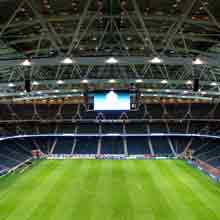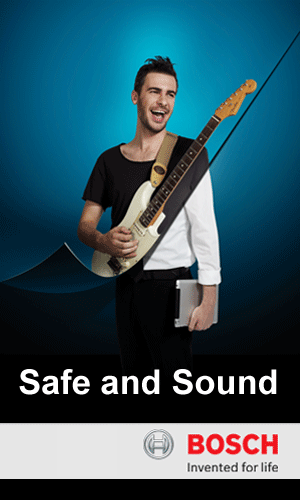 |
| The core of the sound reinforcement solution is made up of compact XLD281 elements from Electro-Voice |
In the Friends Arena in Solna (near Stockholm), Sweden has a new national stadium. Three years in the construction, the 65,000-seater stadium, designed in accordance with the most modern precepts and equipped with a retractable roof, was opened at the end of last year. The stadium will serve as a venue not only for major sporting events, such as the Sweden vs. England association football match that took place on November 14, 2012, but also for major events from the worlds of music and entertainment. In terms of concept, architecture, design and equipment, the Friends Arena is one of the most modern multi-function stadiums in Europe.
The invitation to tender for the sound reinforcement solution was won by the English firm LBI Projects – one of the world’s leading specialists in stadium sound. In addition to its impressive reference list, in which names like “Wembley Stadium” catch the eye, it was the “compact, elegant and efficient sound design concept” proposed by LBI Projects, as that company’s James Hurst is well aware, that clinched the deal. The core of the sound reinforcement solution is made up of powerful, compact XLD281 elements from Electro-Voice’s XLVC line array system.
“The XLD281 three-way cabinet is light and visually unobtrusive, sounds excellent and provides very good coverage of the bass frequencies without requiring any support from subwoofers,” says Hurst. The XLD281 elements are operated with FIR filters, which Hurst considered essential if the required system performance was to be achieved. “Naturally, we also fine-tuned the system,” adds Hurst, “in this case by toning down the preset boosts at 170 Hz, which, whilst it may on a subjective level have led to an initial reduction in loudness, markedly improved transparency – an important quality often notable for its absence in major stadiums.”
The complete audio installation in the Friends Arena is integrated into a redundant Dante audio network on a gigabit, single-mode fibre-optic basis. Nine compact system racks feed all the loudspeakers in the arena. Each of the racks is equipped with CPS 8.5 power amplifiers with RCM-810 remote modules and redundant NetMax N8000 controllers with DM-1 modules for integration into the Dante network. Four identically configured racks are located beneath the roof; these feed not only the twelve markedly curved XLD281 hangs serving the stands but also the eight horn-loaded EVH-1152S/66 coaxial systems from the EV-Innovation family covering the playing area, with one quarter of the stadium assigned to each rack. Five additional system racks are housed in the ground floor of the arena; these serve all the ancillary zones, such as passageways, catering facilities and areas not normally open to the public, including the banqueting hall, which is equipped with 14 EVF-1152S/64 loudspeakers. Full control and supervision of all the racks is assured by IRIS-Net software.
As is generally the case with modern stadium installations, the sound reinforcement system in the Friends Arena is linked to the evacuation system. The latter, in this case, consists of around 500 ceiling loudspeakers, complemented by 340 horn-loaded speakers for recorded music, 75 bi-directional loudspeakers and three Digital Message Players – all from Bosch. As soon as danger threatens, the voice-alarm system assumes control of the entire system. The result: simple, intuitive handling and the swiftest possible reaction in the event of an emergency.
The feedback from the operators of the stadium has been positive, reports Hurst. Even experts like Steve Liddle, Project Consultant with Springwell AB, are “totally enthusiastic about the performance, the evenness of the coverage, the high sound pressure levels and the excellent intelligibility.” In the coming months, the system will have every opportunity to convince a wider public, as not only further football matches but also concerts by Bruce Springsteen, KISS and Elton John, among others, are on the agenda.




